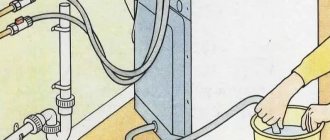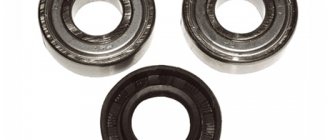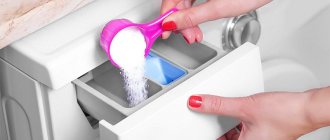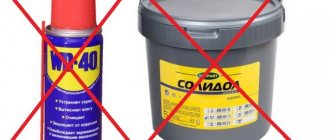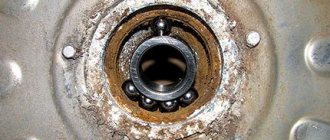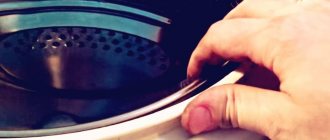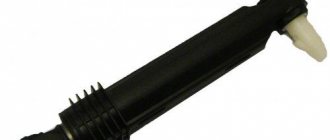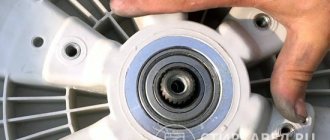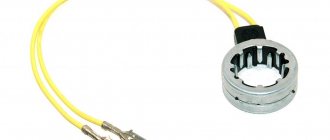Manufacturers of large household appliances pay great attention to the safety of their products on the way to the end consumer. High-quality packaging almost completely protects the units from any external damage, provided, of course, that transportation rules are followed. At the same time, due to the design features, the washing equipment contains devices that prevent damage to internal parts and mechanisms. Regardless of the type, each washing machine on the assembly line is equipped with transport bolts.
Features: Shipping bolts on LG washing machine
Washing machines from one of the leading brands, LG, are equipped with a wrench, the task of which is to help remove the transport bolt, making the task easier for the owner of the machine, because the size of the wrench still needs to be guessed.
LG washing machines are packaged in standard boxes the size of the household appliance; a sticker with all the necessary information is placed on the box. Inside the box is foam. It protects the machine from external damage, and the transport bolts from internal damage. The transport bolts can be removed very easily - all you need is a regular wrench.
When loading the washing machine, four transport bolts are installed. They are located on the back panel of the equipment. The kit for removing the transport bolts includes a wrench and plastic valves. If you forget about the transport bolts or decide that they won’t interfere, you may encounter unpleasant consequences: drum noise, knocking inside the machine, the washing machine jumping, even tipping over.
How to organize transportation if fastenings are lost?
We have already written about the correct transportation of the washing machine, but it is worth paying special attention to transportation without bolts - over the years of using the machine, they are easy to lose. To maintain the integrity of internal components when packing, loading, moving, descending and ascending to the floor, follow the recommendations of specialists:. Place the equipment horizontally or on its side (with the powder receiver facing down)
Vertical loading is excluded - in this case the tank will become loose, which can lead to internal damage
Place the equipment horizontally or on its side (with the powder receiver facing down). Vertical loading is excluded - in this case the tank will become loose, which can lead to internal damage.
- Wrap the drum with cloth or foam rubber, you can put pieces of foam plastic.
- Drain the water from the filter and hoses to protect the electrics.
There is no need to go to the trouble of buying screws from other brands. After all, fasteners from Siemens may not fit an Ariston machine. Sometimes, even in the model range of the same brand, bolts are produced in different lengths and diameters and may not fit similar models. Thus, Electrolux produces screws for its machines with a diameter of 6 to 10 mm.
Now you know that transport elements are irreplaceable “guards” of AGR parts, saving them during transportation. Don't lose it and don't forget to remove it before connecting.
Both the factory instructions, the loader, and the store consultant warn: if you do not unscrew the shipping bolts before using the washing machine, inevitable problems will arise. But not everyone knows what exactly awaits inattentive washing machine owners. We propose to understand what consequences can result from fasteners that are not removed in time.
What shipping bolts look like on a washing machine (video)
Based on this article, it can be understood that manufacturers have provided everything to ensure the safety of equipment during transportation; transportation bolts are a mandatory part of this process. Safety should not be neglected, because even the tightest packaging will not protect the machine from damage. Before the first start, do not forget to remove the bolts, save them, and in case of transportation, install them in the right place.
When buying household appliances in a store, it is impossible to do without arranging for their delivery. Heavy and bulky, it does not fit into a passenger car; a cargo transport is needed here. During transportation, the product may be damaged, so when packaging the product, manufacturers must securely fix it. For this purpose, special transport bolts are used on the washing machine, which are removed during installation.
Why do you need shipping fasteners?
The design of the washing machine includes a metal drum that is not tightly fastened. It swings freely in the body of the machine. This design solution allows washing in various modes. But transporting such a unit always causes difficulties. After all, if the washing machine starts to shake violently, during transportation its drum may damage the walls of the case, especially if it is made of plastic.
This transportation problem is solved with the help of special transportation bolts that have a hex head with a pair of washers. These parts firmly fix the internal parts of the product and save it from breakage.
The standard diameter does not exceed 12-14 mm. There are models where fastening is carried out with 10 mm mounting bolts. A rubber washer is in contact with the body, a steel one serves to create a tight fastening. The body of the screw is hidden by a special cylinder made of dense polymer. It fills the small gap between the internal parts of the machine and its body, tightly fixing the parts.
How to transport a washing machine correctly
To transport the washing machine successfully, you must adhere to certain rules:
- clean the washing machine well;
- drain the remaining water;
- remove the hoses;
- remove the plugs by prying the edges with a sharp screwdriver;
- equip the bolts with sealing strips;
- install the mounting bolts.
To properly install the washing machine, it is necessary that the bolts fit exactly into the threaded holes. You will have to tinker with this, since after prolonged use, the threads become clogged. For proper installation, the tank must be slightly rotated by hand.
It is allowed to transport the washing machine on its side with the cuvette pointing down. The best transportation option is considered to be a horizontal position.
If the bolts are lost, you need to order duplicates from the workshop. Manufacturers do not recommend using fasteners from another machine.
From all of the above we can draw a conclusion. The fasteners must be removed for washing. Reinstalled for transport. In the event of a breakdown due to ignoring transportation rules, responsibility falls on the consumer. Warranty service is terminated, expensive repairs are paid by the owner of the product.
Transport bolts are always present in a new washing machine. And if they are not removed before you start using the machine, they can interfere with its normal operation and even ruin your household appliances. In this article we will tell you why these bolts are used, how to find them and what is needed to remove them.
Shipping bolts have a very important function. They are the ones that secure the washing machine tank.
This extremely necessary precaution is needed in order to protect the machine during transportation and lifting to the floor. Thanks to these fixing elements, the internal parts do not come into contact with each other and with the walls when the machine body rolls or tilts during transportation.
This helps to keep not only the washing machine tank intact, but also its other parts. Such as:
- Bearings,
- shock absorbers,
- and other spare parts.
Shock absorbers with bearings provide movable fastening of the tank and reduce its vibration during washing, rinsing and spinning.
Fastening devices. What are they needed for?
Shipping bolts secure the tank in the washing machine. That is why they are extremely necessary when transporting equipment.
To minimize the risk during transportation, they are installed at the manufacturer’s factory, and even with various inclinations during transportation, the internal parts do not contact each other, because the bolts hold the tank in one position.
Thanks to this, shock absorbers and bearings also remain intact.
These are very important elements of a washing machine, as they reduce the amount of vibration during washing and spinning.
What happens if the bolts are not removed?
It should be remembered that the Indesit washing machine should under no circumstances be operated with the bolts not removed! If they are not removed, the device will soon fail, and its repair will be very expensive and difficult. Fastenings for transportation reliably fix the internal moving parts to the body so that they fit snugly and not during shaking and sudden movements. During the washing process itself, such fixation will only interfere. During normal operation, the drum rotating inside should not touch the surrounding walls. Otherwise, he will break them and fail himself. Also, the shock absorbers on which it rests will deteriorate due to improper use.
Strong vibrations and shocks during washing and spinning occur because things inside the drum are constantly moving unevenly and the center of gravity is constantly changing. The laundry hits different parts of the drum, and if the fasteners securing it are not removed, these impacts will be transmitted to other parts. Thus, not only the drum, which is not designed to collide with the housing, is at risk of failure, but also the engine, as well as the bearings and systems through which water is collected and drained.
It should be remembered that since the cause of such breakdowns is improper operation of household appliances, the Indesit machine will not be subject to warranty repair. At the same time, replacing and restoring all damaged parts can cost a lot of money.
How to remove
And this is not a long process.
The vast majority of washing machine manufacturers include a device for removing fasteners in the unit package.
First of all, turn the automatic machine so that there is free access to the rear panel of the case. There is no need to disassemble the unit to remove the bolt fastening.
Next, using a wrench of a certain size, the fastener is unscrewed, rotating counterclockwise. Removing the shipping bolts by hand is not difficult.
The last dismantling step is to mask the holes using special plugs.
The plug is inserted into the slot until it stops. A characteristic click will indicate the correctness of the manipulations.
Plastic plugs to hide the opening from fasteners are necessarily included in the components. Removed fasteners - bolts, washers and plastic inserts - should be bagged and saved as they may be needed over time.
For example, if you change your place of residence, you will need to move the washing machine to a new address and reconnect it. In this case, it is necessary to ensure rigid fastening of the tank using transport bolts.
They are mounted in the same places from which they were removed earlier. If parts are lost, new ones must be purchased.
You may also be interested in an article about the most common faults of washing machines.
Read an article about what to do if the washing machine door does not open here.
If you ignore the process of removing the fastening, the following breakdowns and malfunctions are possible:
- vibration, noise, movement of the washing machine during washing;
- additional load on the electric motor, reducing its service life;
- destruction of the shaft and bearings;
- heating element failure;
- broken drive belt.
Important to know: removing the transport bolts when installing the washing machine is a mandatory step.
As you can see, shipping bolts are important elements of the washing unit, preventing untimely damage during transportation and increasing its service life.
Watch the video, which clearly shows how to remove the transport bolts on a washing machine:
Appearance
Shipping mounting screws are a simple design. It includes the following parts:
- hex bolt;
- washer;
- rubber ring;
- plastic insert.
A bolt is an oblong-shaped product with an external thread. It connects the moving parts of the unit. The plastic insert is designed to protect surfaces.
The rubber ring acts as a seal. The metal washer increases the support area and prevents loosening.
In rare cases, the manufacturer uses metal pins.
This is what the shipping bolts look like
Tips for transporting washing machines:
- When transporting a washing machine, if the original packaging has not been preserved, you need to think about what to place the device in to avoid mechanical damage. The equipment body needs reliable protection, as do its components. You can replace the packaging with soft materials you have on hand. Fabric, corrugated cardboard, or stretch film may be suitable for this.
- The structure must be carefully wrapped with improvised means, then tied with a rope to securely secure the new packaging.
- It is better to transport the unit to transport in compliance with important rules. Under no circumstances should you turn it upside down; only a slight tilt back is possible. The device can only be transported while standing or placing it on the back wall. Professional service center technicians advise turning the machine sideways, in the direction the car is moving.
- The detergent intake may contain residual moisture, which will flood the control board, and repairs will be quite expensive. It is possible to avoid an unfavorable situation if you remove the cuvette and transport it separately from the device.
- Carrying devices on the rear wall is available for most models except the Zanussi brand. This manufacturer produces units with heavy counterweights located in such a way that when the equipment is placed in the “rear wall” position, they forcefully press on the fill valve and can damage it.
If all points of correct transportation are observed, the unit will be delivered to its destination in intact condition. All components will be in working order without damage, which means the following negative factors will not occur:
- the network cable will not break;
- the plastic parts of the case will be preserved;
- the hatch cuffs will be intact;
- fastenings, hatch guides and shock absorbers are in perfect order;
- pipes and hoses will remain in working order;
- the drain pump will remain the same;
- provides resistance to oxidation, short circuiting of wiring and contacts.
By following the instructions for operating the equipment, you can extend its service life and avoid additional costs for repairing the device.
Watch the video: How to remove shipping bolts
Transportation instructions
If there is a need to transport the washing machine to a new location, it must be prepared in advance. To do this, we will perform the following steps.
Disconnect from water and electricity
First, disconnect the power wires from the electrical network and disconnect the hoses for water intake and drainage. Often during transportation, the same mistake is made - they begin to move the “washing machine” without unplugging it from the socket. This may damage the cord and hoses where they are attached.
Pour out the water
Even if the machine has not been washed for a long time, there will still be a small amount of water in the hoses that needs to be drained. After draining the residue, leave the hose holes open to dry.
We fix hoses, wires, hatch
The hoses and power cord must be folded and secured so that they are not damaged or interfere with transportation. The hatch for loading laundry and the powder compartment must be in the closed position. To prevent them from opening when moving, we recommend additionally securing them, for example, with masking tape.
Fixing the tank
An obligatory step is to fix the washing machine drum. If the bolts are not preserved, you can unscrew the top panel and fill the space between the tank with improvised materials (foam rubber, bubble wrap, etc.). This way the drum will remain stationary during transportation.
We pack correctly
The last stage of preparation is packing the washing machine. The ideal option is factory packaging, but you can do without it. Hoses and electrical wires must be wrapped in bubble wrap or any soft cloth. The body should be wrapped with stretch film and covered with foam plastic (corrugated cardboard), after which the packaging should be tightly secured using tape. You can replace the foam with a regular blanket by wrapping it around the body with tape. You also need to install the machine for transportation on something soft (any rags, blanket, etc.).
Transportation methods
During transport, it is important to properly install the washing machine in the vehicle. Three options:
- in a natural upright position;
- on the back wall;
- turn over onto the side wall.
When transporting, it is better to order a truck to place the car in a vertical position, since this option is considered the safest.
If there is not enough space (for example, in a car, in a taxi), the car can be placed in a horizontal position on its side. It is better to choose the side that is closer to the powder compartment; in this case, you must first remove the container for detergents and dry the inside of the water so that moisture does not get into the electronics.
Transportation on the rear panel is also allowed, with the exception of models in which the fill valve design does not allow loading the panel. Otherwise, the heavy weight will simply break the valve.
It is strictly forbidden to transport the device upside down and the front panel. In the first case, this can lead to complete breakdown of the equipment, and in the second, to the breakage of the hatch and rupture of the cuff.
What happens if the bolts are not removed?
It should be remembered that the Indesit washing machine should under no circumstances be operated with the bolts not removed! If they are not removed, the device will soon fail, and its repair will be very expensive and difficult. Fastenings for transportation reliably fix the internal moving parts to the body so that they fit snugly and not during shaking and sudden movements. During the washing process itself, such fixation will only interfere. During normal operation, the drum rotating inside should not touch the surrounding walls. Otherwise, he will break them and fail himself. Also, the shock absorbers on which it rests will deteriorate due to improper use.
This will happen due to the fact that the springs, which should absorb most of the vibrations produced during washing, will not work properly due to fixation, and all movements of the drum will be transferred to the body of the machine. This can also lead to additional breakdowns of the machine and damage to the plastic elements of the body.
Strong vibrations and shocks during washing and spinning occur because things inside the drum are constantly moving unevenly and the center of gravity is constantly changing. The laundry hits different parts of the drum, and if the fasteners securing it are not removed, these impacts will be transmitted to other parts. Thus, not only the drum, which is not designed to collide with the housing, is at risk of failure, but also the engine, as well as the bearings and systems through which water is collected and drained.
It should be remembered that since the cause of such breakdowns is improper operation of household appliances, the Indesit machine will not be subject to warranty repair. At the same time, replacing and restoring all damaged parts can cost a lot of money.
What problems can occur if transportation rules are violated?
All recommendations described above must be strictly followed. If you suddenly forgot to provide for something, then transportation may result in expensive repairs, or even the purchase of a new machine.
Here are the main options for the outcome of incorrect transportation:
- a loose power cord can be broken;
- poor-quality packaging of the case can lead to breakage of plastic parts;
- when transporting with support on the front cover, you can get a torn cuff or breakage of the loading hatch fastening;
- a loose or poorly secured drum can lead to repairs to shock absorbers, replacement of bearings and breakage of body panels;
- poorly installed rubber parts can be torn during transportation;
- if you forgot to drain the remaining water, be prepared for failure of the electronic unit, interruptions in power-on due to oxidation of contacts and short circuit of the wiring;
- transporting the “washing machine” upside down guarantees damage to the drain pump;
- If you forgot to secure the powder container with tape, then with a high degree of probability you will bring it broken.
How to remove shipping bolts on a washing machine
It is important to know: until the fastening bolts are removed, the washing machine cannot be used!
If this advice is neglected, then, ultimately, due to improper operation of the entire mechanism, the washing machine will fail. Also, not a single service center will undertake to repair or replace the device free of charge if the transport bolts turn out to be the cause of the breakdown.
Manufacturers generally place shipping bolts on the back wall of the washing machine.
Therefore, as a rule, finding them is not difficult. Usually there are no more than four such bolts.
In some companies they look like small iron pins and can be located, for example, on the top wall.
To be able to start using the washing machine, you just need to unscrew them.
A universal wrench is quite suitable for this.
The required size, as a rule, ranges from ten to fourteen millimeters, depending on the manufacturer's brand. The kit of some companies (for example LG) includes a suitable size wrench for removing the mounting bolts, along with a drain hose and other standard parts of the washing machine.
If you don’t have a wrench on hand, you can try using pliers. And if the manufacturer used metal pins as fastenings, then it is best to unscrew them using pliers. To remove the shipping bolts or pins, simply turn them a quarter turn and then pull them all the way out of the device body by hand.
Almost all kits have small round plugs. They are needed to close the holes left by the mounting bolts. Most likely, they are needed for beauty, but perhaps also to reduce noise during vibrations.
Tips for transporting a washing machine
As practice shows, you should not throw away the transport bolts immediately after removing them, since no one knows what awaits us in the future.
You may have to change your location and move to a new home. This is when the shipping bolts will need to be put back in place to reduce the risk of possible shipping damage.
Decorative plugs can be removed very easily using nail scissors or a regular knife. The fastening bolts can be screwed in without foreign objects, so the whole procedure will not take you much time. Thus, you can increase the operating time of your machine and do not worry about it during transportation.
Can it be transported without bolts?
In this case, you need to remove the top wall of the washing machine and fill the free space with soft materials.
Can be used:
- rags;
- Styrofoam;
- foam rubber
Then the upper wall is put in place and secured with fasteners. Even during rough transportation, the drum and tank themselves will not be subject to impacts and damage the internal walls.
- corrugated cardboard;
- stretch film;
- textile.
Expert advice
When transported in a truck, the automatic machine is installed sideways in the direction of travel.
If other large items are transported in the back, the car must be placed between them so that it does not move, jump, or fall. This eliminates the risk of damaging shock absorbers, contacts and pipes.
Once the machine is packaged and ready for transportation, it must be carried safely to the vehicle, which can also cause problems. The hardest thing is to lower the unit from the upper floors without an elevator.
If this is not possible, then bend backwards.
If the packaging is insufficient, there is a risk that the doors will open during transportation. Although they are closed and held in place using special fasteners, it would be a good idea to secure them with tape or rope.
The empty drain hose is wound up and secured with tape or ties. Additionally, you can wrap them in polyethylene or soft material.
What happens if you don't remove it?
But all these are just external manifestations. In fact, at this time, the mechanism of the washing machine suffers serious damage, as a result of which the unit may become beyond repair. If the washing machine breaks down because you forgot to remove the shipping bolts, the service center will have the right to refuse service under warranty.
These fixing parts must be removed immediately, even before using the machine. If they are not removed in time, then after a while the shock absorbers and bearings will be damaged, and then all the parts of the machine. Over time, the product will become completely obsolete. You can tell that the transport fastenings have not been removed by the following signs:
- During the washing, rinsing and spinning process, the washing machine vibrates strongly, and it begins to “jump” around the apartment.
- During its operation, the machine creates a lot of noise, and other extraneous sounds are heard.
When deciding how to transport a washing machine without transport bolts, you must follow the following several recommendations:
- The position of the washing machine during transportation should be on its side with the ditch down, or horizontal, but in no case vertical. This is due to the fact that when transported vertically without fixing bolts, the tank will become loose and damage internal parts. And when placed on its side with the cuvette facing up, there is a risk of damage to the water control unit, the remains of which may remain in the powder compartment.
- Before transportation, it is necessary to cover the drum with foam rubber, cloth or polystyrene foam.
- Carefully remove all remaining water from the machine. This will prevent damage to the electrical parts of the machine.
It is not recommended to purchase shipping bolts separately, especially from other manufacturers (for example, bolts from a Bosch car are not suitable for Electrolux models). The fact is that the sizes of these parts are different not only among individual manufacturers, but even among models of the same brand. For example, the manufacturer of the Electrolux brand, which is quite successful these days, produces bolts for various models of its cars from 6 mm to 10 mm.
The fate of the guarantee
Even running a washing machine once with transport bolts will forever deprive the owner of the warranty provided to the machine. Washing with fasteners not removed is a direct violation of one of the main requirements of the instructions, which leads to automatic termination of the warranty period. Therefore, if the consumer wants to repair third-party breakdowns at the manufacturer’s expense, the consumer will receive a reasoned refusal from the service center.
It will not be possible to hide the fact of a violation of the warranty. If you do not remove the transportation bolts and start the machine, then characteristic damage will remain on the drum, which is easy to notice even with an unprofessional eye. Any further repairs will have to be paid for out-of-pocket.
Monetary losses are also expected when selling a washing machine.
Attention is paid to the condition of the drum first of all, and there is a high probability that after an unsuccessful start, an unpleasant knock and increased vibration will remain. Therefore, it is better to spend time and double-check again than to go to the store for a new machine
It's easy and interesting to communicate here. Join us!
Once there’s nothing right away, then nothing will happen
There won't be any special problems. The main problems have already been felt - noise, bouncing, etc. The transport screws simply fix the drum during transportation, preventing it from moving freely inside. Free movement is necessary just in the washing mode and, especially in the spin mode. After unscrewing the transport screws, the drum is freely hung inside the machine and the springs and shock absorbers dampen vibrations and noise.
QUOTE: A short digression about what will happen if the transport bolts are not removed
We once received an application for warranty repair of an ARDO A-600X washing machine located in a rural area. When asked what was wrong with the machine, the owner answered briefly: it doesn’t work.
When the master arrived at the place, the following picture appeared before his eyes. The machine worked for 8 (.) months with the transport fastenings not removed. To prevent the machine from jumping around the room, the owner replaced the front rubber support legs with a stationary mount made of a metal corner, fixed with dowels to the floor. In addition, the machine is almost completely covered with brickwork on both sides. After the owner dismantled his structures and removed the machine and opened it, the following was discovered: Complete absence of bearings - shaft? rotated? in the landing bushings of the cross. Due to the beating under the weight of the drum, the edge of the pulley facing the tank was completely worn out, simultaneously cutting through the crosspiece, causing the drive belt to jump off and break. Further disassembly revealed even more terrible consequences of the owner’s lack of intelligence - the drum cut off the heating element and the front part of the tank, which simply fell off under the weight of the front counterweight. The belt apparently broke after that. When water poured out of the cut tank onto the floor and the machine stopped completely, the owner decided to call a technician to carry out warranty repairs! According to the master, he had to explain to the client for quite a long time about his violation of the terms of the warranty and the inappropriateness of restoring this machine. .
Manufacturers of large household appliances pay great attention to the safety of their products on the way to the end consumer. High-quality packaging almost completely protects the units from any external damage, provided, of course, that transportation rules are followed.
At the same time, due to the design features, the washing equipment contains devices that prevent damage to internal parts and mechanisms. Regardless of the type, each washing machine on the assembly line is equipped with transport bolts.
Where are the shipping bolts located?
The washing machine differs from other devices in that it has a freely moving internal part - a tank with a drum. This is the heaviest part of the unit. It is suspended on powerful springs from the inside of its body, and rests on shock absorbers from below.
When the machine is in one place and not exposed to external factors, its rotating part does not come into contact with other structural elements. However, during transportation of household appliances, it is allowed to tilt them in different planes. In this case, the loose rotating mechanism of the machine can:
- fly off and/or become deformed;
- damage or puncture the tank;
- disrupt electronic control circuits.
To avoid damage as a result of falling or shaking, special fixing elements for the washing machine are used during transportation - transportation bolts. This is the name given to fasteners designed to hold the rotating part of the unit stationary and maintain proper balancing of the drum. In spin mode, this element gains high speed. Its misalignment relative to the axis of rotation leads to strong vibration of the device, increased loads on shock absorbers and bearings and a reduction in their service life.
For all models with front loading and almost all with vertical loading, they are located in the same place - on the rear panel of the case. A rare exception are some top-loading machines: they are equipped with additional protective bolts under the top cover of the unit.
Design of fasteners
The body of the washing machine has pear-shaped holes with a small recess at the bottom. A bolt is placed in the hole, which is equipped with a plastic and steel washer. The plastic one is used on the side of the body so as not to scratch the surface. Steel is used as a tightening reinforcement, in which the clamp head will not destroy the plastic.
The fastener also has a plastic drum that fits over the bolt. This drum, together with the bolt, is inserted into the hole in the tank until it stops. Then the entire structure is lowered into the recess, thanks to which a secure fastening is achieved. Then the clamp is screwed into the nuts of the tank of the machine.
What are they and what do they look like?
The details are quite easy to identify at first glance. They are large and easily stand out from the rest of the bolts and parts of the back wall. they look like ordinary threaded bolts with a thick hex head made of plastic and a metal washer. They connect the body and the drum and prevent its deformation.
Shipping bolts are temporary fasteners that are installed on new devices to ensure that the shipping process causes less damage to them. In this case, we are talking about fasteners that secure the washing machine drum, protecting it from deformation and breakdowns that can occur as a result of an impact or fall of the unit during transportation.
The only functional unit of the washing machine that is not rigidly fixed is the tank. It is attached from below to dampers (shock absorbers) and from above to springs. No matter how carefully you transport or carry the washing machine to the installation site, strong shocks cannot be avoided.
Therefore, a structural element that does not have a rigid fastening inside the body will inevitably move in all directions at the slightest shock. This can be avoided by installing shipping bolts (supplied with the appliance).
Installation of fixing parts is carried out at the manufacturer's plant.
The tank-fixing elements look like metal pins of different lengths (depending on the model and manufacturer of the washing machine). Their main task is to keep the tank in a static position during shocks and at the same time not cause damage to the less durable body or elements. Therefore, the transport bolts on the washing machine are supplemented with steel, rubber and plastic washers.
The soft plastic part is designed to come into contact with the housing - it does not damage it under shock loads, and the metal part securely holds the pin in the housing hole and prevents the head of the bolt from pressing through the surface of the housing.
Depending on what kind of washing machine the consumer purchases, from 3 to 6 metal fixing parts can be used when transporting equipment. But usually there are 4 of them.
They are used to ensure reliable and stationary fastening (there is some distance between the tank and the wall of the housing, and this is filled with plastic fasteners).
Usually these details are easily visible on the surface. However, some manufacturers produce non-standard models, on the back wall of which it is difficult to find fixing points.
They are clearly indicated in the instructions for the equipment.
It is necessary to remove the shipping bolts from the washing machine, and only then start using it.
For what? The shock absorbers and springs used to secure the tank inside the body perform the function of damping vibrations and preventing the increase in its swing.
The “stowed position” does not allow springs and shock absorbers to perform their tasks, and therefore equipment that works with pins will soon break down. But the main thing is that it will cause a lot of trouble during use.
If you do not remove the transport bolts, the washing machine will:
- jump (literally) across the floor, moving in all directions;
- make loud noises;
- vibrate very strongly;
- Poor distribution of laundry in the drum.
Metal shipping bolts in a washing machine can also have different head sizes. To remove them you will need a regular wrench (10, 12 or 14) or a special wrench supplied by the manufacturer with the equipment. In addition, pliers are required.
The instructions supplied with the equipment must address the issue of how to remove the transport bolts by selecting a suitable wrench. The extraction process is simple. The metal pin just needs to be unscrewed and removed from the housing. For some models, the pin is removed using pliers. It is required to turn the bolt head a quarter turn with a little effort and remove the rod.
It may happen that the plastic fastener inserts, when removing the metal pins, fall inside the body of the household appliance. They must be carefully removed by slightly tilting the machine. Do not leave plastic parts inside.
They may come in handy if you need to install shipping bolts when transporting equipment to another location. In addition, the presence of plastic parts inside the case can cause noise and damage.
Bolts and other fasteners removed from the washing machine should not be thrown away. They will come in handy when moving. The installation procedure is as easy as the removal procedure. All steps must be done in reverse order.
What can break?
Removing the shipping bolts is a matter of minutes, but simple haste and inattention can play a bad joke on the owner.
After all, if you forget about the fasteners, you can forever lose the machine you just purchased or get yourself into trouble with the warranty and further operation. This perspective can be explained simply. The bolts used during transportation are designed to secure the movable drum of the washing machine. This prevents it from sagging and rotating during transportation and ensures safe and sound delivery. But starting a cycle with the drum stationary will only do harm:
- convulsive “jumps” around the room;
- uncontrolled vibration;
- loud knocks.
All this is the most harmless thing that will happen in this case with the washing machine. More often the matter ends much worse - the drum is damaged, and the machine itself fails.
It is forbidden to turn on the washing machine with transport bolts precisely because of excessive fixation. The drum clamped with screws does not “hang” on vibration-softening shock absorbers, and all shocks from the accelerated motor go directly to the body. The situation is aggravated by the imbalance of the laundry, which crumples and causes random shocks. The type of drive does not matter - non-functioning dampers will harm both direct-drive machines and belt-driven vehicles.
It’s easy to avoid an unpleasant prospect - just remove all the transport bolts in time. Or check the work of the installers: look at the back panel of the machine and make sure that there are closed or unclosed holes in their place. If you can’t find the grooves for the fasteners, you can look at the instructions and check the data sheet. As a rule, four large screws are used for fixation, the absence of which is easy to notice.
Removing the screws: instructions
So, the car was delivered to the apartment. Of course, you want to connect the unit and start washing as soon as possible, but it’s better not to rush. First, let the washer “rest” at room temperature for several hours. Next, we remove the factory stickers and set up free access to communications, electricity, water supply and sewerage. We deal with transportation bolts only after all the manipulations described above.
The clamps are removed using a special key, which is usually included with any Indesit model. If it is not there, then we find a 12mm head or pliers. Next we proceed like this.
- Loosen the screws by unscrewing them by 3.5-4 cm.
- We push the bolt inside the housing until it rests on a hard surface (on average, a recess of 2-2.5 cm is enough).
- Without touching the screws themselves, remove the rubber gaskets and the plastic tip.
- We close the vacated holes with special plastic “plugs”, which are included with Indesit washing machines. The main thing is to press on the lids until you hear a characteristic click.
But do not rush to throw away the removed shipping fasteners. It is better to pack them and store them along with the instructions and other documentation. They will come in handy the next time you transport the car, if it is sold or moved. Do not forget that it is strongly not recommended to transport machine guns without bolts.
How to remove fasteners yourself?
When your long-awaited purchase—a washing machine—arrives at your home, do not rush to connect it to communications and start a big wash. Take your time:
- Give the appliance time to reach room temperature, regardless of the time of year.
- If the supply to communications - the drainage system, water supply and electricity - is provided, proceed to “disarm” the machine. If not, read our connection guide.
- Use the appropriate size wrench (or adjustable wrench). And if you have an Ariston, Indesit, Bosch, Elgie or Electrolux car, then the key may be included.
Didn't find the key? Use pliers available in any home.
- Unscrew the screws 3.5–4 cm - not all the way, just loosen them.
- Feed each screw forward, pushing it all the way into the equipment (about 2 cm deep).
- Without removing the bolts, remove the rubber bands and plastic inserts, and then remove the fasteners themselves.
- There will be quite impressive holes in the wall. Don’t leave them like this: moisture can get into the case through them, and a few extra “holes” can affect the noise level. Find plastic plugs in the packaging materials and install them in the holes, pushing them until they click.
More details in the video:
Where are the fasteners located and how to remove them?
Most household washing machines have several technological holes on the back cover intended for installation of transport bolts. Their number usually does not exceed six, but most models have four transport bolts.
For example, Samsung washing machines typically use a four-location locking pattern. Since the back wall of any unit is not overloaded with an abundance of elements, it is quite easy to find fasteners. In addition, their location is necessarily indicated on the diagram in the operating instructions, so it is best to start getting acquainted with your new household assistant with it.
Removing the transport fastenings
The fastenings are removed immediately before the operations of connecting and installing the equipment in its original place. Unscrewing the bolts must be done using a wrench of the required size. You can also use a universal adjustable wrench, or a special wrench supplied with the washing machine.
To remove the transport bolts, you must first use a wrench to loosen all connections by unscrewing them counterclockwise. Then remove them by pulling them towards you. At the final stage of work, the remaining holes on the rear wall of the case are closed with special plastic or rubber plugs included in the machine package. The plugs are inserted into the unit body and fixed with light hand pressure, and do not require special tools. During operation, they protect the internal space of the device from dust or other objects that can cause malfunctions.
When dismantling the fasteners, it is necessary to ensure that the rubber and plastic bushings do not remain in the housing, and if they do fall during removal, they must be removed from there. After removal, all parts must be preserved, for example, placed in a package with technical documentation.
How to remove shipping bolts on a washing machine
After the machine is delivered to the owner, it must be installed and connected to all the necessary terminals. After installation and connection, you can start using the machine
When installing, it is very important not to forget to remove these bolts, which will interfere with washing and spinning.
You can remove the transport bolts using an adjustable wrench.
The bolts can be removed quite easily; for this you will need a wrench of the required size, or an adjustable wrench that adjusts to the bolt by unscrewing or twisting.
Do not throw away the bolts that you have removed, but rather put them in a certain place along with the documents for the equipment. If your equipment suddenly breaks down, it will need to be transported to a service center, and transportation without this part is impossible.
How to install
When moving to a new place of residence or if the washing machine breaks down, it may be necessary to transport it. The device must not be transported without replacing the bolts removed before use.
Before installing fasteners, the device should be disconnected from communications and freed from residual water. Then remove the plugs and complete the fastening with 2 sealing washers and a safety pad. The bolts must be inserted into their original places so that their ends fit into the threaded holes on the inside of the housing. The process is completed by carefully tightening the fasteners with a wrench.
